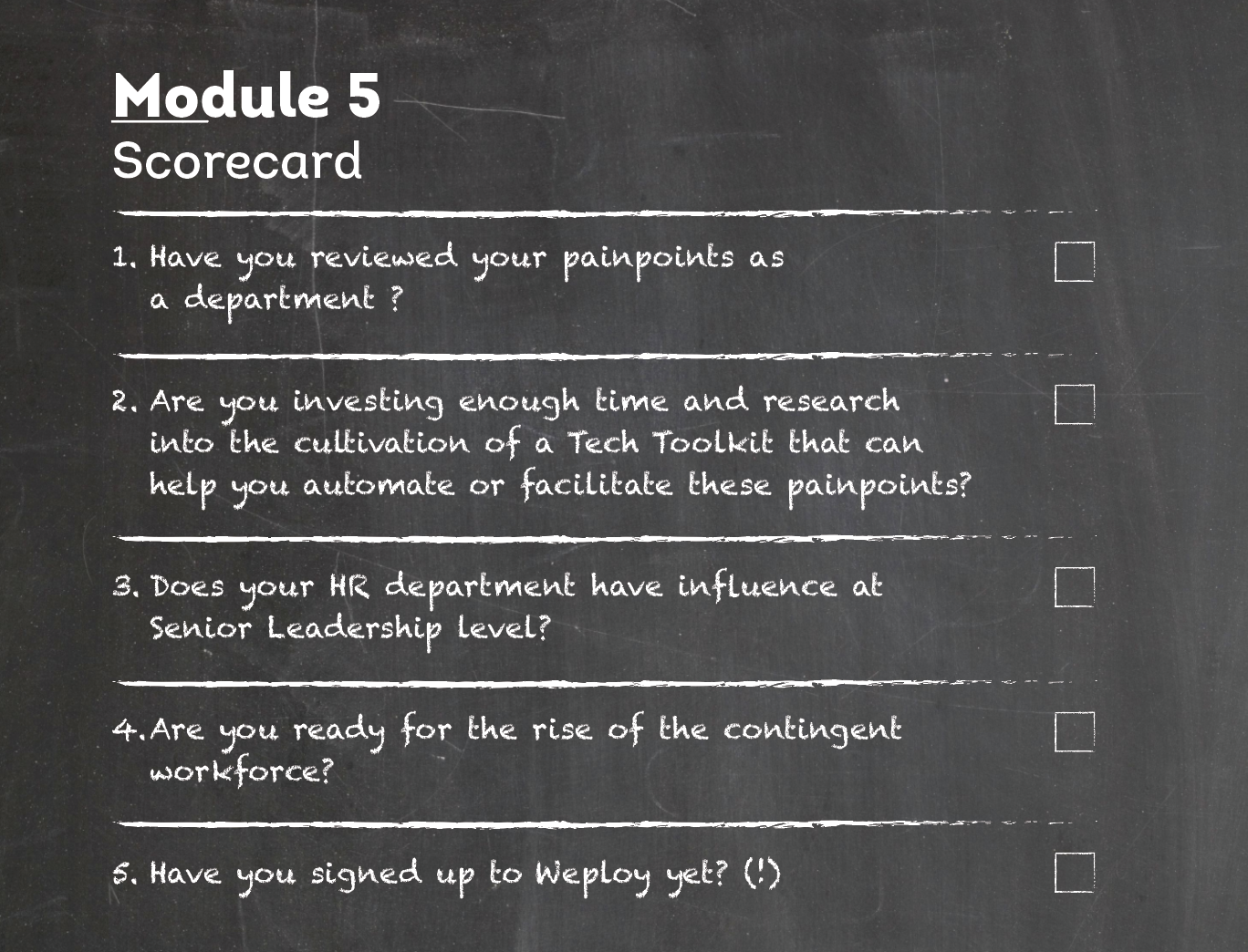Non-Millenials are 2.3x more likely to stay when they have a strong connection to the company purpose
For talent today, job satisfaction is not necessarily correlated to salary. It is getting more important for employees to feel connected to a wider purpose, and see how the company is making a difference to the lives of others and the wider world. For day to day happiness, employees crave an understanding of how they are contributing to that company purpose, values and beliefs, not just the commercial goals.
Non-Millenials are 2.3x more likely to stay when they have a strong connection to the company purpose
The emergence of the Contingent Workforce has brought to light a new world of work, where employees can fit their jobs or “gigs” around their lives, instead of the other way around. Technological advancements mean that jobs can be performed when we choose, and from environments that we feel most comfortable and productive in. All this means that the question of “Why” we are working becomes all the more important.
The discrepancy here reveals that businesses today must be educated in how better to translate the company purpose from the top down, and ensure it is prevalent in every decision made
The Future work mindset is project-oriented and focused on gaining experience and knowledge. The company purpose must be added into recruitment strategy from first touch in order to retain full time staff.
Customers will never love a company until the employees love it first.

Simon Sinek
Organisational design expert
and best-selling author
A Mission Statement will clarify the “what,” the “who,” and the “why” of a company. It’s the roadmap for the company’s vision statement, and a good one will combine both the values that bring market success and the values that contribute to a better world

Build the best product, cause no unnecessary harm, use business to inspire and implement solutions to the environmental crisis.

To create a better everyday life for the many people.

For full engagement, the day to day must be directly correlated to the mission/purpose of the company and employees need to find meaning in their work. Only 27% of business leaders guide supervisors to have conversations with their teams about why their work matters. This should be 100%
A common reason that these conversations are not happening is a lack of time. Using Tech/Automation for processes will allow business leaders to focus on the meaningful aspects of their teams’ jobs and deliver more PURPOSE to the day to day. Outsourcing administrative or lower skills-based tasks will allow more time for the values and purpose driven tasks involved in jobs at all levels of the company.
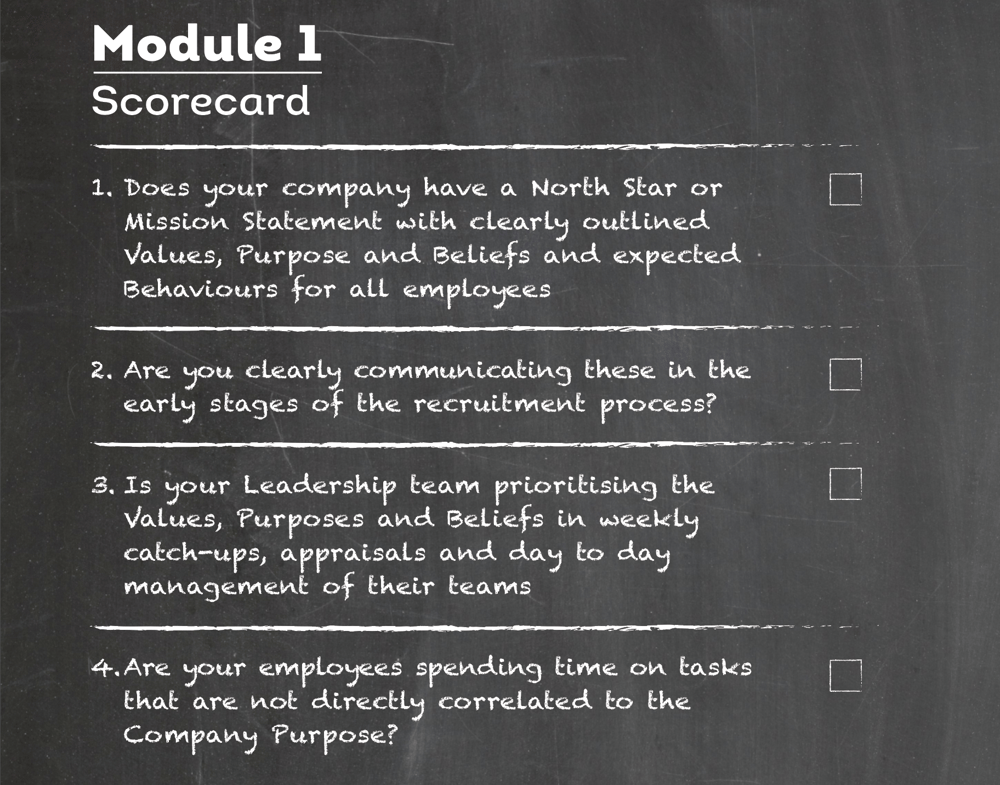
Importance of employer brand for attracting candidates
... of candidates research about firm’s reputation and employer Brand before applying for job
... of Employers say that Employer Brand plays a significant role in their ability to hire talent
... of candidates would NOT accept a job in a firm with a bad reputation even if they wouldn’t have a job

In an era when peer to peer reviews, user-generated feedback and personal endorsement is regarded more highly than anything else, the way your organisation is perceived in the marketplace is more important than ever. Defined, Employer Branding is how you market your company to attract future talent.
It hinges on a well-defined EVP (Employer Value Proposition) which will encompass your mission, values and culture, and give employees a powerful reason to work with you. Going beyond salaries, perks and benefits - the EVP will communicate everything your company can offer above all others, in exchange for employees’ skills, talent and experience.
- A thoughtful and employee-centric EVP can:
- help to attract and retain the best people,
- help prioritise company wide goals and agenda’s,
- help to re-engage a demotivated workforce and
- reduce hiring costs long term.
As with all branding, crafting a strong employer brand is about telling the story of your EVP. It’s about how you want your organization to be perceived in the marketplace, using specific messaging to help attract the kind of prospects you’re looking for. But also, it’s about “living out that story.”
(Tim Mundy, The Digital Affair)
Ideally, the driver of the Employer Brand should be a C-Level member. But it is not just what the CEO says it is any longer. An authentic Employer Brand must start and end with the Employees themselves. Then, the heads of HR and Marketing must work together so that the person who understands the employees best, and the person who is best at telling stories, are responsible for the organisation and external communication of your Employer Brand.
Whilst your EVP may define what employees get out of working for your company, your employer brand tells other people about it. The goal of your employer branding efforts is to convince outsiders that they will receive value from working for you.
The New School of Recruitment teaches that effective Employer Branding will mean half of the work in attracting new applicants is already done because the reputation of your company will speak for itself and attract the right applicants. If the EVP is compelling enough, your satisfied employees will become your best advocates (See Module 3 - Workplace Culture)

“When employment branding first came around, we thought of it as something separate to the consumer brand, but in the last 10 years, we have all started to learn and realise that our ideal candidate is also our customer, in many cases. So it makes no sense to have separate brand messages because it’s the same person. The biggest change we have seen in employment branding in the last 10 years is that coming back together of the brand messaging and recognising it’s not something that separate. You just need to tweak the story slightly whether you’re aiming to talk to one of your customers, or to a candidate.”
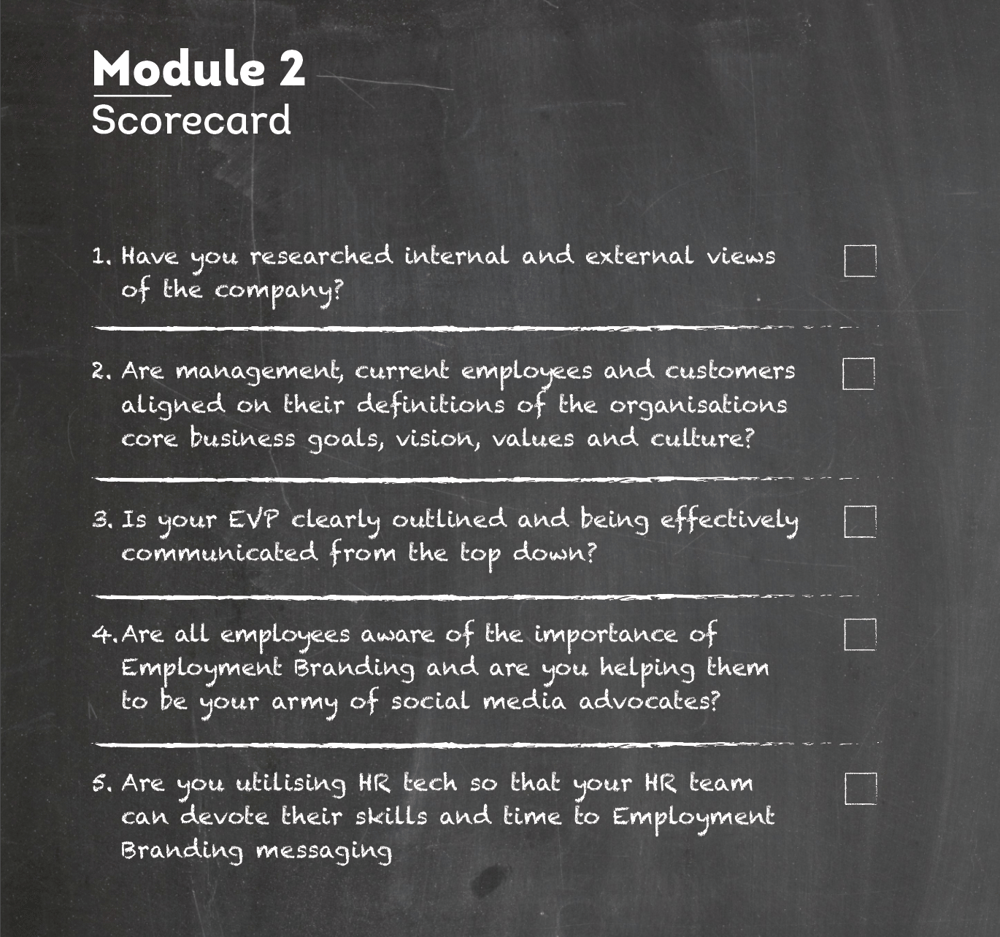
Ever present yet intangible, like the thread stitching a sleeve onto a jacket, or the cement between the bricks of a mansion, the “Culture” of a workplace is the sense of “How things are done around here”. Often seen as a tiresome or “uncool” area of old school HR - curating workplace culture can be difficult, but experts say it is key to being able to scale successfully, with benefits including
- Reduced employee turnover
- Improved employee satisfaction levels
- Improved workplace productivity
- Higher retention
- A fun, positive and healthy environment
If “Culture” is the sense of “How things are done around here”, Employee Engagement is “how employees feel about how things are done around here.” Engagement is an aspect of workplace life that can—indeed, should—be continuously monitored in a proactive way. It is about the future of an organization; it is a measure of corporate health and a key window into the potential for future issues.

It’s not difficult to understand why:
of the Australian Executives responding to Deloitte’s 2016 Global Human Capital Trends survey said they believe that Employee Engagement is an “Important” or “Very Important” priority for their companies,
Of the U.S. workforce is not engaged, according to Gallup’s State of the American Workplace report. These employees are indifferent and neither like nor dislike their job - which in today’s war on talent, is an enterprise wide risk
But business units in the same report who scored highly on Employee Engagement recorded:
Reduction in absenteeism
Increase in Productivity
To attract talent for all types of businesses from corporates to SMEs and startups, a palpable company culture is essential and informs the backbone of a company Employer Value Proposition. It must be developed organically, and curated proactively because as time goes on, stitches can loosen or the bricks can become misaligned or misshapen. If left to chance - outcomes can be catastrophic. So what does good look like? Culture in the New School of Recruitment is about:
- Values alignment (See Module’s One and Two)
- Employee Engagement
- Flexible and remote working options
- Learning and development
- Well-being and Work/Life Balance
- Compensation and benefits beyond pay package

Workplace Culture in the New School of Recruitment needs a top-down, “always on” approach, to match the way employees are approaching their professional and personal lives today.
Fortunately, new solutions have emerged in the marketplace to help with the assessment and maintenance of workplace culture…
A new generation of “pulse” survey tools and open anonymous feedback systems can allow employees to rate managers, executives, and just about everything else at work on a near-real-time basis. The thoughtful use of such tools can create a true “listening environment” for employees while giving leaders critical insight into what’s working and what’s not working in the company.

Josh Bersin
Bersin by Deloitte
Although statistics show that good Workplace Culture has a direct correlation with business performance, the success of it is not completely dependent on the delivery of business goals. Meaningful metrics for conscious effort into Company Culture should be about: Absenteeism/Employee Health, Social Media Reviews, Careers Website Ratings, Turnover, and Retention

A whopping 82 percent of fortune 500 executives don’t believe that their companies recruit highly talented people.
... know who are high and low performers
... retain high performers
... develop people quickly and effectively
...quickly remove low performers
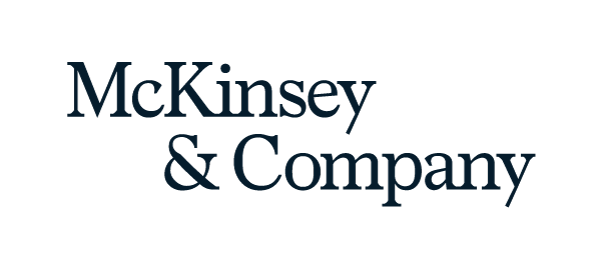
Source “Mckinsey Global Survey: War for talent 2000.” refreshed in 2012
And almost one third of senior leaders cite finding talent as their single most significant managerial challenge
Technology underpins every business and every function within it today, and as such, competition in the industry is fierce. Employees are looking beyond a fancy title and a competitive pay package and looking to be heard, interested to know how they will progress, and can contribute to the company values. Flexible working opportunities and health and wellbeing benefits are becoming a standard part of the offering. This is discussed in Module 1 - The Purpose of Work. Beyond a clear EVP however, one of the top ways companies successfully retain and attract tech talent, is by creating learning opportunities that promise to advance their careers.
A report by LinkedIn states that the main reason people leave their jobs, and the main reason why they join an organisation are the same: Career Opportunity.
of employees say they would remain longer with an employer that provided a clear career path
People left their old job because they expressed concerns for lack of career development
Joined another company because of a stronger career path or more opportunity.
Ways of creating further learning for employees might be:
- Providing opportunities for hands-on experience outside of the day-to-day.
- Offer on-demand training resources that support ongoing development.
- Be transparent about organisational challenges and direction.
- Invite questions and suggestions on these issues.
- Coach with clear and constructive feedback during meetings and regular one-on-one conversations.
- When planning work, ask employees to identify how they can contribute and what they want to learn.
A workplace culture that “promotes from within” is the smartest way companies can support career opportunities and better engage and retain current employees, but also help to keep the leadership pipeline filled with strong internal candidates. It’s a win-win.
In Australia, just 23.66% of STEM grads are women and 28% of the Tech workforce are women, so companies have a responsibility to ensure they are hiring for diversity within the tech industry. But minimising talent to numbers is a dangerous game.
Going to the root cause is a more meaningful way of making a difference than working towards a pre set quota for equal employment opportunities:

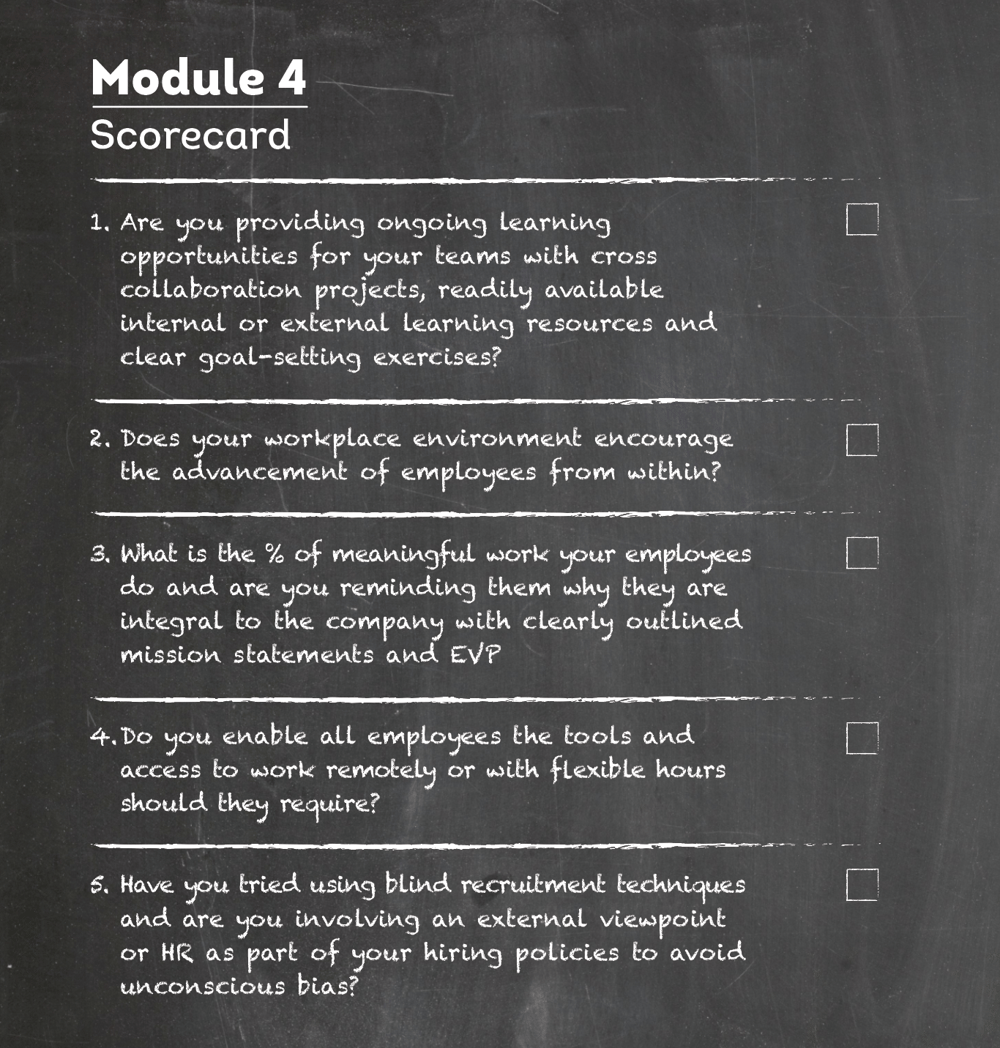
The future of work
Technology is already playing a huge part in the Future of Work. A report by McKinsey reveals that about 60% of all occupations have at least 30% of activities that are technically automatable, based on currently demonstrated technologies. The same report calculates that the adaptation of current automation technologies could affect:
50% of the world's economy
1.2 billion Employees
$14.6 trillion in wages

Only 5% of jobs can be fully automatable however, and for recruitment specifically - there will always be a need for humans at the heart. Where technology will really help HR is in Workflow Performance Improvements - Automation and AI will help to drive efficiencies and can facilitate sourcing.
Technological advancement should be embraced not feared...
To set themselves up for success in the future of work, HR teams must first identify their pain points and work out how tech and automation can facilitate these. With the resulting time and resource spared, people teams can focus on the more human-centric and creative elements of recruitment.
Some of these may be:
- People Analytics
- EVP and Branding
- Strategic Sourcing
- Continuous Performance Management
- Testing of and migration to Cloud-Based ATS and LMS

The rise of the Contingent Workforce is a trend that cannot be ignored, and the benefits for both employees and employers are manifold. As the management of multiple different types of employees within one company becomes more prevalent, recruiters must ask themselves: “Can we manage contract and contingent workers within HR or should we outsource management to procurement?”
Proportion of U.S workers in non-full-time work situations (contractor, part-time worker, gig worker, or contingent worker)
Australians employed on a casual basis in 2018
But companies are simply not ready for the rise of the Contingent Workforce. Research into HR organisations shows that:

There are quite a few categories of contingent work platforms today. Vendor management systems help companies manage vendor contracts and more than 75% of companies manage contractors through the purchasing department, not the HR department. But HR must open their minds and adopt this “Shadow Workforce”,
in order to achieve better internal talent mobility and improve leadership skills, give people more development opportunities, and increase the agility and productivity of their teams
